Jack salmon are no one’s little brother! The difference between coho jacks and regular salmon help us maintain critical ecosystems.
Jack salmon have a unique life cycle that does play a distinct role in the salmon population.
What is Jack Salmon?
Jack salmon are juvenile males that return to fresh water to spawn at a younger age than the typical mature males.
The average salmon, those large beauties, spend a solid 18 months at sea – growing big and large.
But jack salmon usually spend around six months in saltwater before migrating back to their natal streams. This early return makes them smaller in size, sometimes ten times smaller, but crucial for genetic diversity within salmon populations. In short, sly little jacks help prevent inbreeding.

Physically, jack salmon are distinguishable by their size (they’re way smaller) and sometimes less pronounced (meaning, dull and boring) spawning colors. They inhabit the same freshwater rivers and streams as adult salmon but can be found returning earlier in the season.
Don’t count out the little jacks though when it comes to spawning! While they’re not as big or strong, they’re fast. Jack salmon ensure the resilience and adaptability of salmon populations by contributing their genes during spawning in a sneaky way. It’s actually known as the “sneaking technique”.
Female salmon have no interest in jacks. They’re weak and small. But while the regular-sized salmon are fighting it out for dominance to seed eggs, the little jacks sneak up behind and fertilize as many eggs as possible and run off.
What is “Regular Salmon”?
Regular salmon, or adult salmon, follow a more extended life cycle, spending several years in the ocean before returning to spawn. The term “regular salmon” encompasses various species, including Chinook, Sockeye, Coho, Chum, and Pink salmon. Each species has unique characteristics, migration patterns, and spawning habits.
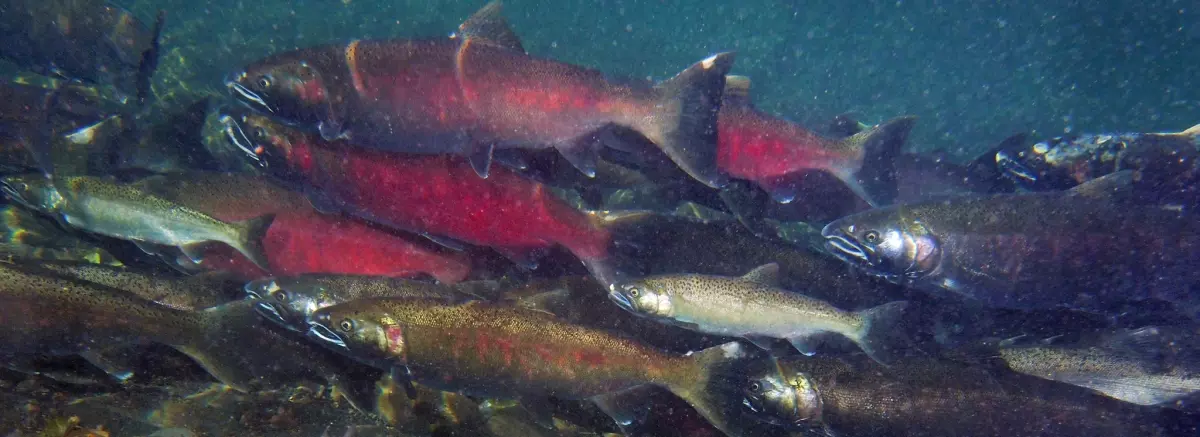
Same species, but jacks are dull in color and much smaller.
Another jack.
Did you notice the two jacks trying to blend in among the large coho salmon?
For instance, Chinook salmon, known as King salmon, can spend up to six years at sea before returning to freshwater rivers to spawn. These mature salmon are significantly larger than jack salmon and exhibit distinct physical traits, such as black gums and large, hooked jaws during spawning.
For comparison, jack chinooks will only spend 12 to 18 months at sea.
Key Differences Between Jack Salmon and Regular Salmon
No need to overcomplicate this! All anglers and conservationists should already know the differences between jack salmon and regular salmon, but just in case… Here are the main distinctions:
- Size and Age at Maturity: Jack salmon are younger and smaller, typically spending only one year in the ocean. Regular salmon mature over several years, growing larger and developing more pronounced spawning features.
- Migration Patterns: Jack salmon return to their natal streams earlier than regular salmon. This difference in timing can affect fishing strategies and conservation efforts.
- Spawning Habits: Both jack salmon and regular salmon contribute to the spawning process, but jack salmon’s early return provides a genetic bridge, enhancing the population’s resilience to environmental changes.
Fishing for Jack Salmon vs. Regular Salmon
Fishing for jack salmon requires different techniques compared to regular salmon. Here are some tips to help you succeed:
- Jack Salmon: Use lighter tackle and smaller lures or flies, as jack salmon are smaller and more agile. Focus on early season fishing, when jack salmon are more likely to return.
- Regular Salmon: Equip yourself with heavier tackle to handle larger fish. Different salmon species may require specific strategies; for example, fly rods work well for Coho salmon, while trolling is effective for Chinook.

Practical Tips for Fishing and Conservation
- Identify Your Catch: Learn to distinguish between jack salmon and regular salmon by size and physical characteristics.
- Follow Regulations: Adhere to local fishing regulations to protect vulnerable stocks.
- Support Conservation Efforts: Participate in habitat restoration projects and support policies that promote sustainable fishing practices.
Species of Salmon
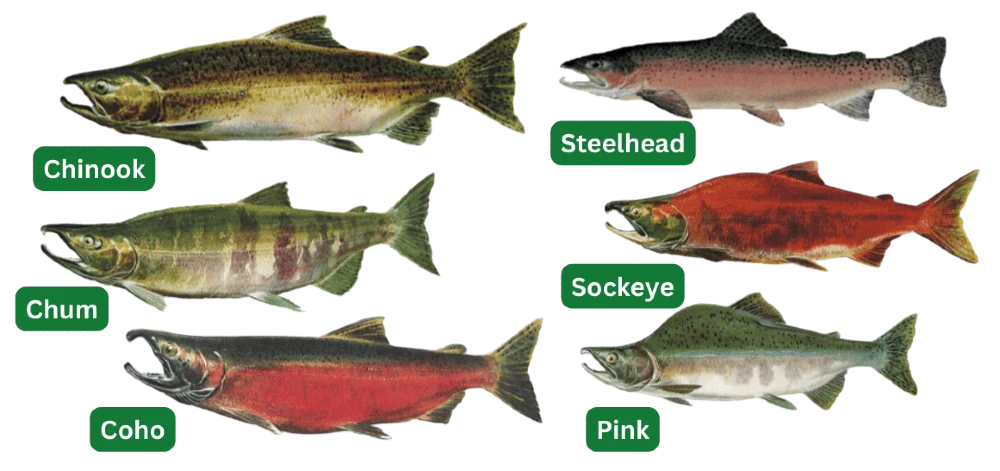
The term “salmon” includes a variety of species like Chinook, Sockeye, Coho, Chum, Steelhead, and Pink salmon. Each species has unique characteristics, migration patterns, and spawning habits.
For example, Chum salmon are known for their distinctive spawning colors and late return to freshwater, often spawning from October to March.
And each species have jacks!
Migration and Spawning
Salmon migrate from the ocean to freshwater areas to spawn. They return to their natal streams, often overcoming obstacles like waterfalls and dams. The migration patterns and timing can vary significantly among species. For instance, Coho salmon return to freshwater in the fall, typically from September to December, while Chinook salmon can return in different runs throughout the year.
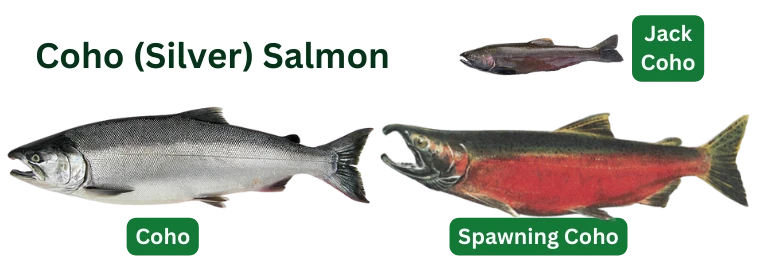
Jack Coho and Coho Jack
Jack Coho, or Coho Jack, are younger, precocious males of the Coho salmon species that return to freshwater to spawn after only around six months in the ocean. Keep in mind that regular coho salmon will spend up to two years at sea. Like other jack salmon, they are smaller than their older counterparts but play a crucial role in maintaining genetic diversity.
Physical Characteristics
- Lobes of the Tail: Different salmon species can be identified by the shape and markings on their tail fins.
- White Gum Line: Chinook salmon have a black gum line, while other species like Coho salmon have a white gum line.
- Black Spots: The presence and pattern of black spots on the body and tail can help identify different species of salmon.
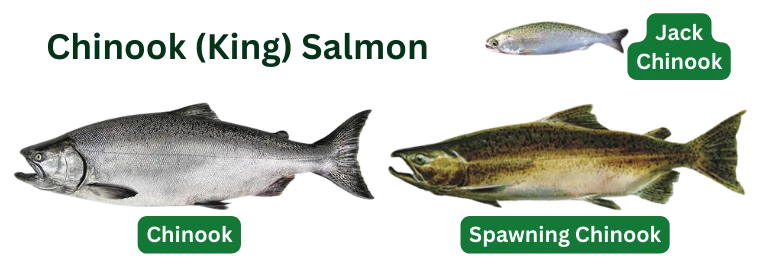
FAQ
Q: What is the main difference between jack salmon and regular salmon?
A: Jack salmon are younger, much smaller males that return to freshwater to spawn after only one year (or less) in the ocean, which stunts their growth. Regular salmon mature over several years and are significantly larger.
Q: How can I identify jack salmon when fishing?
A: Jack salmon are smaller and have less pronounced spawning colors compared to regular salmon. Pay attention to size and physical characteristics.
Q: What are the best fishing techniques for jack salmon?
A: Use lighter tackle and smaller lures or flies, and focus on early season fishing, when jack salmon are more likely to return.
Q: How do regular salmon species differ from each other?
A: Regular salmon species, such as Chinook, Sockeye, and Coho, have unique migration patterns, spawning habits, and physical traits. For example, Chinook salmon are larger with black gums, while Sockeye salmon are known for their bright red spawning colors.
Q: What role do jack salmon play in the ecosystem?
A: Salmon die after spawning. The large salmon, whether Chinook or Coho or other variety, are often snagged by nets, bears, raptors and for cultural uses. But little jack carcasses serve another purpose – fighting invasive species!
Coho jack carcasses in particular make for irresistible bait to trap European green crabs, which have become a non-native scourge on both US coasts.
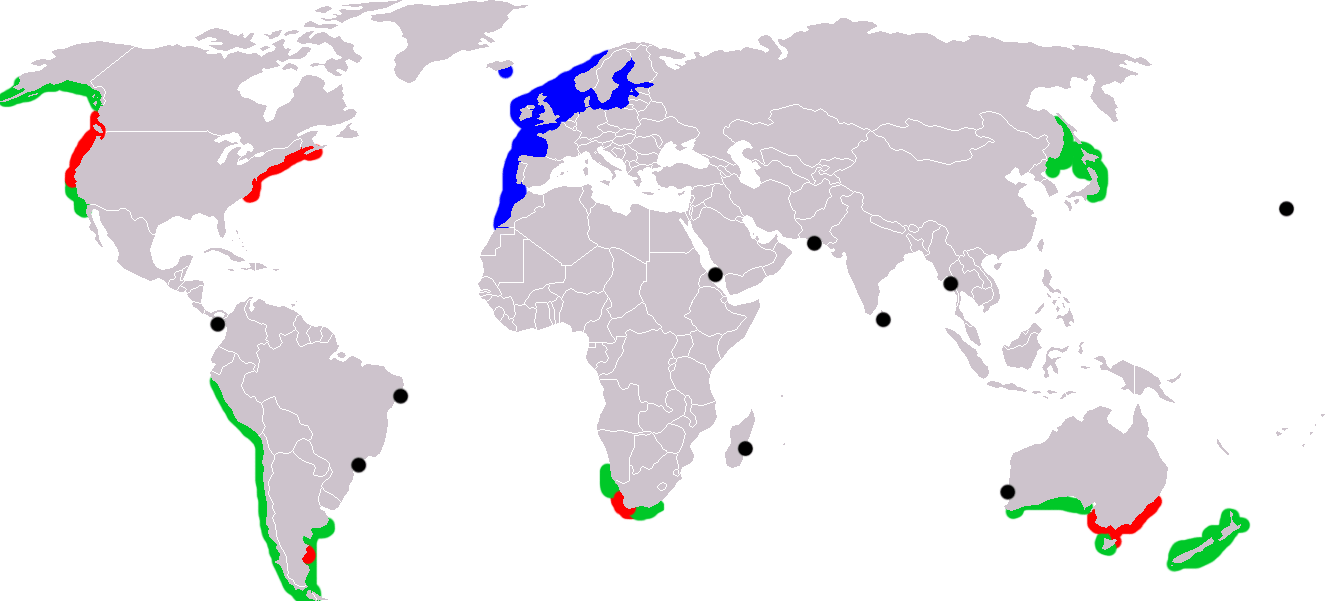
Q: Why is conservation important for both jack and regular salmon?
A: Conservation efforts ensure the sustainability of salmon populations, protecting their ecological roles and supporting healthy ecosystems. That’s the boilerplate, but the reality is a bit harsher. As much as we, as people, love talking about the omega-3 fatty acids that salmon gives us (as does flaxseed, yogurt and tuna), orcas depend on salmon more than us. When wild salmon populations dive, orcas starve and die. Look at what happened when people accidentally killed and wasted 30,000 salmon in Canada.
Q: What are the main differences between Chinook and Coho salmon?
A: Chinook salmon, also known as King salmon, are larger and have a black gum line. Coho salmon, or silver salmon, are smaller with a white gum line and are known for their aggressive behavior when hooked.
Q: How does water temperature affect salmon migration?
A: Water temperature plays a deep role in salmon migration. Cooler temperatures signal the time for salmon to begin their journey back to freshwater spawning grounds. Jack salmon tend to do their own thing because they don’t wait for the ocean temps to determine their return to freshwater.
Q: What are some conservation strategies for protecting salmon?
A: Conservation strategies include habitat restoration, sustainable fishing practices, and regulations to protect spawning grounds and migration routes. It has long been assumed that farming salmon would lead to ecological recovery in the wild, unfortunately, recent info is proving the exact opposite.
More To Discover
- 5 Seafoods That Went From Obscure and Ugly To Super Popular Thanks To Some Shrewd Marketing Makeovers
- China’s Massive Trawler and Fishing Fleet Is Causing Devastation In And Out of The Ocean and No One Will Stop Them
- Scotland Is Taking On The ‘Organic’ Salmon Industry, Calling It “Greenwashing”
- U.S. Coast Guard Helps Vanuatu Expose Illegal Fishing by Chinese Vessels
Conclusion
Jack salmon and regular salmon play unique and vital roles. Understanding their differences helps anglers succeed and supports conservation efforts. By recognizing the importance of both types of salmon, we can ensure the sustainability of these incredible fish for generations to come. Happy fishing! 🐟



















